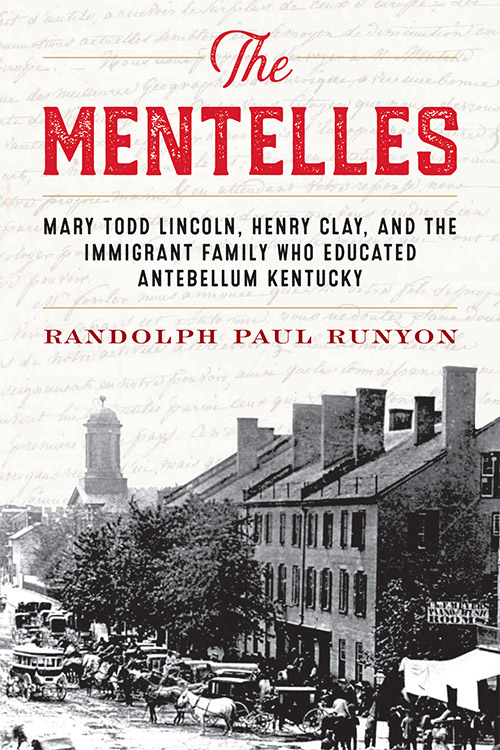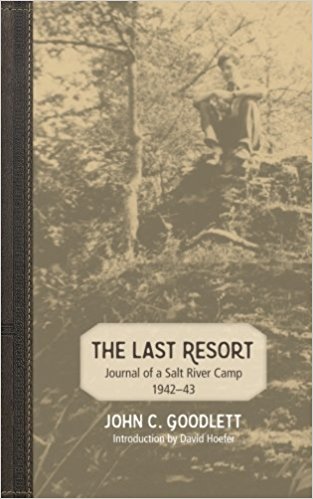The Mentelles: Mary Todd Lincoln, Henry Clay, and the Immigrant Family Who Educated Antebellum Kentucky
by Randolph Paul Runyon
Lexington: The University Press of Kentucky
271 pp., $40
Review by Katherine Dalton.
Entire contents copyright © 2018 Katherine Dalton. All rights reserved.
Despite what the title implies, there is very little in this book about Mary Todd Lincoln, Henry Clay, or education in the early years of Kentucky. This is, instead, a commendably researched study of the life of two French immigrants who came to early Lexington and made their lives there: Waldemar and Charlotte Mentelle. Author Randolph Paul Runyon is a professor emeritus at Miami of Ohio and the great-great-great-great grandson of his subjects. Hence his interest in personal, though he has written a study for the general reader.
The Mentelles were not refugees of the French Revolution as they later claimed to be—at least not in the sense they implied. As Runyon deduces from a number of surviving letters, Waldemar was the feckless son of the well-regarded Parisian geographer and academic Edme Mentelle and his wife Leone, herself an able musician who was a student of Clementi. Before and after the Revolution the family lived on pensions and royal grants and Edme taught and wrote many books. They were French intellectuals but given the era that meant they were also cadgers of patronage.
Waldemar’s education was inconsistent and he did not take advantage of the opportunities he had. And so his father, despairing of his son’s ability to apply himself to any work and worried he would be drafted into the Army, pushed Waldemar to emigrate to America to find his living there. Waldemar probably sailed from France to America in 1789, spending some time living mostly on the charity of other Frenchmen in New York and Philadelphia, and then moving to the French settlement of Gallipolis, in Ohio, in 1791. There this academic’s son was employed an “Indian spy,” which meant he walked out of the settlement into the forest 25 to 30 miles a day, looking for signs of trouble. It was quite a change from Paris.
Charlotte LeClerc had fallen in love with Waldemar in Paris, where she had a very different upbringing and was better educated—by a father who treated her more like a son, with privations that seem to have strengthened her character and resourcefulness. A much later observer of the couple thought she was by far the stronger and more manly character of the family, and the many letters Runyon quotes bear this out.
She emigrated to America in 1794 and was reunited with Waldemar at Gallipolis where they married that year. Among the personal effects she brought was a blunderbuss, given to her by her father so she could defend herself against the Indians. (It still exists, in the Waveland Museum in Lexington.) They left Gallipolis—which was not a healthy or successful settlement—for Washington, Kentucky, and then finally arrived in Lexington in 1798. They would spend the rest of their lives there.
Life for them was never easy. Waldemar lacked any trade and clearly, from some of Charlotte’s letters, felt himself (as an intellectual’s son) to have been above much of the company he was obliged to do business with. Some of the work he took on seems to have been above his strength. Rightly or wrongly, both Mentelles felt they experienced prejudice as foreigners, while nevertheless being admitted to Lexington’s good society as educated Parisians. Waldemar started out in the city offering to teach French and dancing (the latter was in particular demand) and had a relationship with Transylvania as a “steward” who offered lodging for students, but he and Charlotte were Deists as well as foreigners and he soon quarreled with the severe Presbyterians who took control of the university. He farmed but had no money to buy land. He took up painting and gilding. He tried selling groceries and started what Runyon says was the first stoneware kiln in Kentucky. In time, he became a reasonably successful horse doctor.
He and Charlotte (whose ability to write correct French was considerably better than his) also wrote various other Frenchmen begging for money, including members of the du Pont de Nemours family, Napoleon, and the evasive Edme Mentelle, who comes across as a remarkably self-centered parent. Edme was a man who was able to survive and even prosper as an intellectual under Louis XIV, then the Revolutionary government, then Napoleon, then Louis XVIII, but he had little help to send to his son in America, and showed no sign of wishing him to return to France, as he and Charlotte so longed to do.
The couple may never have really felt at home in their adopted country. Certainly in their early decades here, they complained greatly about Americans in general and Lexington in particular. Of Lexington society Charlotte wrote, “It is not that we much love the arrogant rich of this place, but some are respectable. And as we are in a situation that does not excite their envy with regard to fortune, nor their extreme contempt with regard to education (though few of them have enough of it to judge), we keep some friends among those who have appeared to us to merit the distinction of those who think intelligently.”
To the extent this attitude was apparent to their neighbors, it must have been tiresome. And given that they were shown some real kindness by, among others, Henry Clay and his family, who gave them hospitality and employment (one of his sons also married a daughter), or Mary Todd (Polly) Russell Wickliffe, who gave them life interest in a tract of land on which they built their house and lived for many years, it sounds ungrateful.
That said, it is useful to be reminded how rough Kentucky settlements were in their earliest days, and how the terrible confusion, legal battles and outright fraud caused by competing land grants made havoc of more than one family’s living and must have truly hampered the efforts many new Kentuckians were making to settle this state.
One of the later Mentelle projects was their most famous one: Mrs. Mentelle’s School for Young Ladies. Her students included Mary Todd. Runyon does not have much to say about either the school or its best-known student, a job he leaves to other writers, but he does quote the biographer Jean H. Baker who wrote that Charlotte Mentelle could be credited with “cultivating in her pupil ‘lifetime fluency in French, a distaste for Lexington, an interest in reading and writing, and an unshakable fascination with royalty.’” That is a very mixed bag of blessings. For her own part, Mary Todd Lincoln seems to have always remembered the school fondly.
Prof. Runyon’s research uncovered many letters the Mentelle family wrote and with them, he is able to make plausible arguments separating fact from fiction in the story of their lives. As they saw need or advantage, none of the Mentelles were above exaggerating, misstating or omitting key facts from their past, and he has done some excellent work sorting things out.
As he observes, their final resting place–like their home–was a gift from a generous neighbor. They lie in the Lexington Cemetery, in one of the four Henry Clay family plots, right next to the Great Compromiser’s mother.
Katherine Dalton lives in Louisville and most recently was a contributor to Localism in the Mass Age: A Front Porch Republic Manifesto (Wipf and Stock Publishers).





